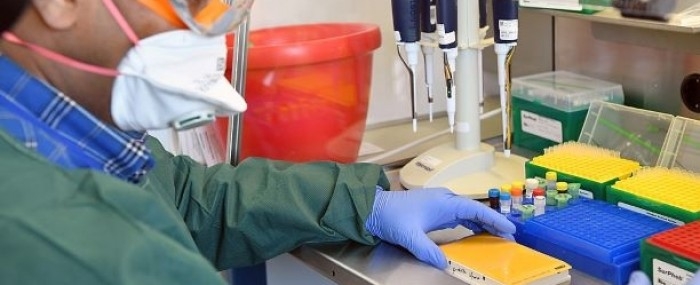


Through a project supported by FAPESP, the São Paulo-based firm is developing an RT-qPCR diagnostic kit in which all reactions take place in a single tube (photo: Wikimedia Commons)
Published on 03/19/2021
By Eduardo Geraque | Agência FAPESP – Considered the gold standard to diagnose COVID-19, the RT-qPCR (reverse transcription quantitative polymerase chain reaction) test is now usually performed as what is known as a singleplex assay, in which a sample of nasal or throat mucus secretions is processed in four tubes with different detection markers in search of genetic material belonging to the novel coronavirus SARS-CoV-2.
Experts say that the procedure makes the test expensive and time-consuming, thus limiting its application.
Through a project supported by FAPESP’s Innovative Research in Small Business Program (PIPE), Cellco Biotec, a startup established in São Carlos, in the state of São Paulo (Brazil), is developing an RT-qPCR kit that works by the multiplex method, in which all reactions take place in a single tube.
According to the startup’s researchers, the method enables many more samples to be processed at the same time and makes the test cheaper because smaller amounts of reagent are required.
The project was one of the first six selected in a call for proposals issued by PIPE-FAPESP in partnership with FINEP, the Brazilian government’s innovation agency, to support the development of products, services or processes by tech startups and small businesses in the state of São Paulo to combat COVID-19.
“We aim to shortly deliver to the Brazilian market a wholly indigenous multiplex RT-qPCR detection kit,” said Naiara Utimura Torres, the principal investigator for the project.
According to Torres, in most labs, the machine that analyzes secretion samples can simultaneously process 96 tubes from 24 patients (four tubes each), taking approximately two hours to do so. Cellco’s method enables the same machine to process samples from 96 people in the same amount of time.
“This is possible because the fragments of genetic material processed to detect the virus are analyzed all at once in a single tube,” she said. In other words, the method uses one tube per patient instead of four.
Biotechnological challenge
One of the main challenges of the project, Torres explained, is producing a single reaction medium in which all four enzymes, which are used separately in the conventional method, can perform the same function in a harmonious manner inside a single tube. “Four enzymes are always required to perform the RT-qPCR test,” she said.
One of the enzymes is reverse transcriptase, which converts the viral genome from RNA to DNA. Another inhibits viral RNA degradation. The third reveals by fluorescence that viral genetic material is present in the sample.
If the virus is detected, its genetic material is replicated millions of times. The light emitted by the fluorescent molecules that bind to the DNA sequences is seen by a sensor in the RT-qPCR machine and is interpreted as a sign of infection. Depending on the intensity of the light, it is even possible to estimate the viral load in the patient.
The fourth enzyme relates to the specificity of the test, ensuring that it genuinely detects infection by SARS-CoV-2 without cross-contamination, Torres explained.
“We’re currently conducting tests to guarantee that these four enzymes will work together harmoniously in the same reaction medium,” she said.
At the start of the pandemic, she added, companies in other countries developed multiplex RT-qPCR tests, but these imported kits are expensive in Brazil because of exchange rates and the strong demand for the kits. Her firm already produces 90% of the inputs required by the standard RT-qPCR test, and they have been validated through a partnership with researchers at the University of Campinas (UNICAMP) (read more at: agencia.fapesp.br/33199).
Also referred to as a molecular test, RT-qPCR can detect the virus early on in the infection, between the third and seventh day after symptoms first appear, and subjects who test positive can be isolated sooner in order to reduce transmission.
Serological tests verify the immune response and are efficient only at a later stage – starting on the eleventh day after symptoms appear, by which point antibodies will have been produced.
Source: https://agencia.fapesp.br/33891